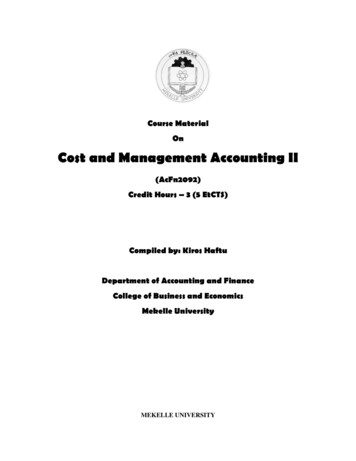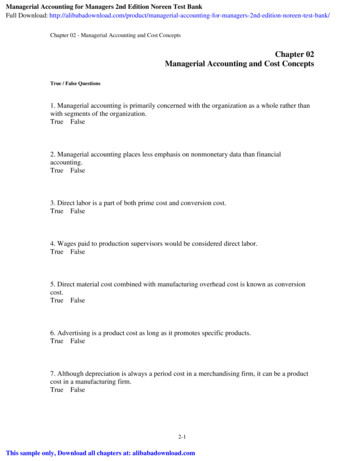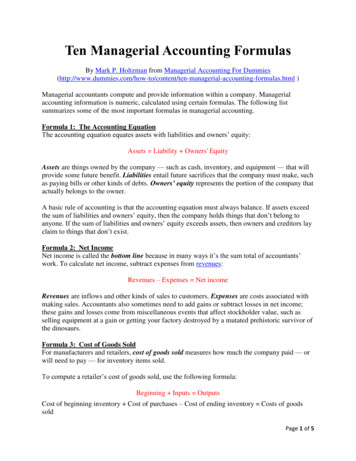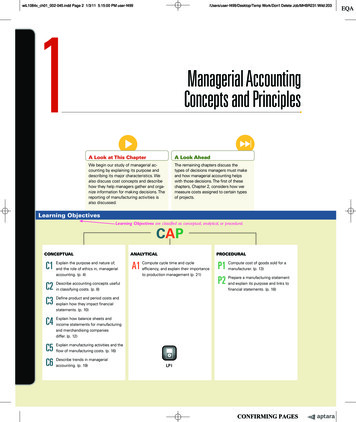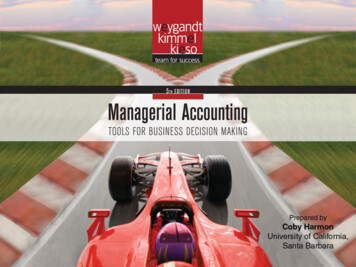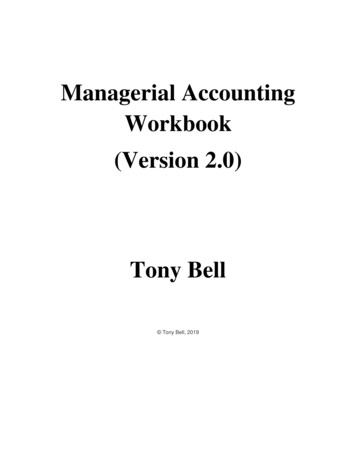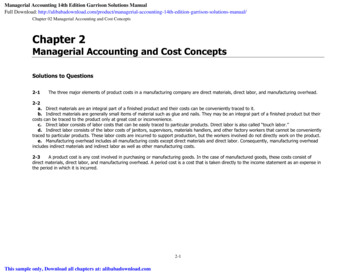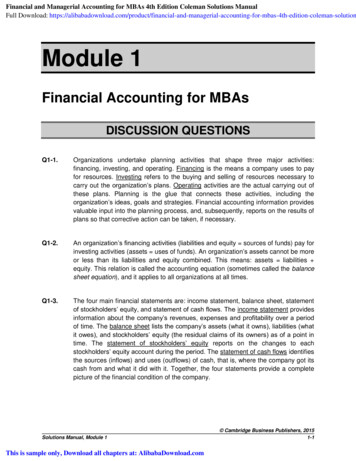
Transcription
Financial and Managerial Accounting for MBAs 4th Edition Coleman Solutions ManualFull Download: -solutionModule 1Financial Accounting for MBAsDISCUSSION QUESTIONSQ1-1.Organizations undertake planning activities that shape three major activities:financing, investing, and operating. Financing is the means a company uses to payfor resources. Investing refers to the buying and selling of resources necessary tocarry out the organization’s plans. Operating activities are the actual carrying out ofthese plans. Planning is the glue that connects these activities, including theorganization’s ideas, goals and strategies. Financial accounting information providesvaluable input into the planning process, and, subsequently, reports on the results ofplans so that corrective action can be taken, if necessary.Q1-2.An organization’s financing activities (liabilities and equity sources of funds) pay forinvesting activities (assets uses of funds). An organization’s assets cannot be moreor less than its liabilities and equity combined. This means: assets liabilities equity. This relation is called the accounting equation (sometimes called the balancesheet equation), and it applies to all organizations at all times.Q1-3.The four main financial statements are: income statement, balance sheet, statementof stockholders’ equity, and statement of cash flows. The income statement providesinformation about the company’s revenues, expenses and profitability over a periodof time. The balance sheet lists the company’s assets (what it owns), liabilities (whatit owes), and stockholders’ equity (the residual claims of its owners) as of a point intime. The statement of stockholders’ equity reports on the changes to eachstockholders’ equity account during the period. The statement of cash flows identifiesthe sources (inflows) and uses (outflows) of cash, that is, where the company got itscash from and what it did with it. Together, the four statements provide a completepicture of the financial condition of the company.Solutions Manual, Module 1This is sample only, Download all chapters at: AlibabaDownload.com Cambridge Business Publishers, 20151-1
Q1-4.The balance sheet provides information that helps users understand a company’sresources (assets) and claims to those resources (liabilities and stockholders’ equity)as of a given point in time.Q1-5.The income statement covers a period of time. An income statement reports whetherthe business has earned a net income (also called profit or earnings) or incurred anet loss. Importantly, the income statement lists the types and amounts of revenuesand expenses making up net income or net loss.Q1-6.The statement of cash flows reports on the cash inflows and outflows relating to acompany’s operating, investing, and financing activities over a period of time. Thesum of these three activities yields the net change in cash for the period. Thisstatement is a useful complement to the income statement, which reports onrevenues and expenses, but which conveys relatively little information about cashflows.Q1-7.Retained earnings (reported on the balance sheet) is increased each period by anynet income earned during the period (as reported in the income statement) anddecreased each period by the payment of dividends (as reported in the statement ofcash flows and the statement of stockholders’ equity). Transactions reflected on thestatement of cash flows link the previous period’s balance sheet to the currentperiod’s balance sheet. The ending cash balance appears on both the balance sheetand the statement of cash flows.Q1-8.External users and their uses of accounting information include: (a) lenders formeasuring the risk and return of loans; (b) shareholders for assessing the return andrisk in acquiring shares; and (c) analysts for assessing investment potential. Otherusers are auditors, consultants, officers, directors for overseeing management,employees for judging employment opportunities, regulators, unions, suppliers, andappraisers.Q1-9.Managers deal with a variety of information about their employers and customersthat is not generally available to the public. Ethical issues arise concerning thepossibility that managers might personally benefit by using confidential information.There is also the possibility that their employers and/or customers might be harmed ifcertain information is not kept confidential. Cambridge Business Publishers, 20151-2Financial & Managerial Accounting for MBAs, 4th Edition
Q1-10.AProcter & Gamble’s independent auditor is Deloitte & Touche LLP. The auditorexpressly states that “our responsibility is to express an opinion on these financialstatements based on our audits.” The auditor also states that “these financialstatements are the responsibility of the company’s management.” Thus, the auditordoes not assume responsibility for the financial statements.Q1-11.BWhile firms acknowledge the increasing need for more complete disclosure offinancial and nonfinancial information, they have resisted these demands to protecttheir competitive position. Corporate executives must weigh the benefits they receivefrom the financial markets as a result of more transparent and revealing financialreporting against the costs of divulging proprietary information to competitors andothers.Q1-12.BGenerally Accepted Accounting Principles (GAAP) are the various methods, rules,practices, and other procedures that have evolved over time in response to the needto regulate the preparation of financial statements. They are primarily set by theFinancial Accounting Standards Board (FASB), a private sector entity withrepresentatives from companies that issue financial statements, accounting firmsthat audit those statements, and users of financial information. Other bodies thatcontribute to GAAP are the AICPA, the EITF, and the SEC.Q1-13.BCorporate governance is the system of policies, procedures and mechanisms thatprotect the interests of stakeholders in the business. These stakeholders includeinvestors, creditors, regulatory bodies, and employees, to name a few. Soundcorporate governance involves the maintenance of an effective internal auditingfunction, an independent and effective external auditing function, an informed andimpartial board of directors, governmental oversight (such as from the SEC), and theoversight of the courts.Q1-14.BThe auditor’s primary function is to express an opinion as to whether the financialstatements fairly present the financial condition of the company and are free frommaterial misstatements. Auditors do not prepare the financial statements; they onlyaudit them and issue their opinion on them. The auditors provide no guaranteesabout the financial statements or about the company’s continued performance.Solutions Manual, Module 1 Cambridge Business Publishers, 20151-3
Q1-15.Financial accounting information is frequently used in order to evaluate managementperformance. The return on equity (ROE) and return on assets (ROA) provide usefulmeasures of financial performance as they combine elements from both the incomestatement and the balance sheet. Financial accounting information is also frequentlyused to monitor compliance with external contract terms. Banks often set limits onsuch items as the amount of total liabilities in relation to stockholders’ equity or theamount of dividends that a company may pay. Audited financial statements provideinformation that can be used to monitor compliance with these limits (often calledcovenants). Regulators and taxing authorities also utilize financial information tomonitor items of interest.Q1-16.Managers are vitally concerned about disclosing proprietary information that mightbenefit the company’s competitors. Of most concern, is the “cost” of losing somecompetitive advantage. There traditionally has been tension between companies andthe financial professionals (especially investment analysts) who press firms for moreand more financial and nonfinancial information.Q1-17.Net income is an important measure of financial performance. It indicates that themarket values the company’s products or services, that is, it is willing to pay a pricefor the products or services enough to cover the costs to bring them to market and toprovide the company’s investors with a profit. Net income does not tell the wholestory, however. A company can always increase its net income with additionalinvestment in something as simple as a bank savings account. A more meaningfulmeasure of financial performance comes from measuring the level of net incomerelative to the investment made. One investment measure is the balance ofstockholders’ equity, and the comparison of net income to average stockholders’equity (ROE) is a fundamental measure of financial performance.Q1-18.Borrowed money must be repaid, both the principal amount borrowed, as well asinterest on the borrowed funds. These payments have contractual due dates. Ifpayments are not prompt, creditors have powerful legal remedies, including forcingthe company into bankruptcy. Consequently, when comparing two companies withthe same return on equity, the one using less debt would generally be viewed as asafer (less risky) investment. Cambridge Business Publishers, 20151-4Financial & Managerial Accounting for MBAs, 4th Edition
MINI EXERCISESM1-19. (10 minutes)( millions)Assets 47,540 Liabilities 36,839 Equity 10,701Dell receives more of its financing from nonowners ( 36,839 million) than from owners ( 10,701million). Its owner financing comprises 22.5% of its total financing ( 10,701 million / 47,540million). Thus, nonowners finance 77.5% of Dell’s total assets.M1-20. (10 minutes)( millions)Assets 16,787Liabilities Equity 13,072 3,715Best Buy receives more of its financing from nonowners ( 13,072 million) than from owners( 3,715 million). Its owner financing comprises 22.1% of its total financing ( 3,715 million / 16,787 million).M1-21. (15 minutes)( millions)AssetsHewlett-PackardGeneral MillsTarget 108,768 22,658(c) 48,163Liabilities 85,935(b) 14,562 31,605 Equity(a) 22,833 8,096 16,558The percent of owner financing for each company follows:Hewlett-Packard .General Mills .Target .21.0%35.7%34.4%( 22,833 million / 108,768 million)( 8,096 million / 22,658 million)( 16,558 million / 48,163 million)General Mills and Target are more owner financed, while Hewlett-Packard (HP) is morenonowner financed. General Mills and Target are financed with roughly the same level of debtand equity, while HP’s debt percentage is significantly higher than that of General Mills andTarget. All three enjoy relatively stable cash flows and can, therefore, utilize a greater proportionof debt vs. equity. As the uncertainty of cash flows increases, companies generally substituteequity for debt in order to reduce the magnitude of contractual payment obligations.Solutions Manual, Module 1 Cambridge Business Publishers, 20151-5
M1-22.A (15 minutes)In its September 30, 2012 annual report, Starbucks reports the following figures (in millions):Assets 8,219.2 Liabilities 3,104.7 Equity 5,114.5As shown, the accounting equation holds for Starbucks. Also, we can see that Starbucks’nonowner financing is 37.8% ( 3,104.7 / 8,219.2) of its total financing.M1-23.A (20 minutes)DuPontStatement of Reinvested EarningsFor Year Ended December 31, 2012Beginning reinvested earnings, December 31, 2011 .Net income for 2012 .Common stock dividends .Preferred stock dividends .Treasury stock retirement* .Ending reinvested earnings, December 31, 2012 . 13,4222,788(1,593)(10)(321) 14,286* Treasury Stock represents the company’s repurchase of Common Stock. The effect is to decrease stockholders’equity, which is the opposite effect from the issuance of stock. During 2012, DuPont retired Treasury Stock andwill not reissue these shares again. This transaction reduced the company’s retained earnings, but did not affectnet income for the year.M1-24. (20 minutes)a.b.c.d.e.BS and SCFISBSBS and SESCFf.g.h.i.BS and SESCF and SESCF and SEIS, SE, and SCF Cambridge Business Publishers, 20151-6Financial & Managerial Accounting for MBAs, 4th Edition
M1-25. (10 minutes)There are many stakeholders impacted by this business decision, including the following (alongwith a description of how): You as a Manager—your reputation, self-esteem, and potentially your livelihood could benegatively impacted.Creditors and Bondholders—credit decisions based on inaccurate information couldoccur.Shareholders—buying or selling shares based on inaccurate information could occur.Management and other Employees of your company—repercussions of your decisionextend to all other employees. Also, a decision to record these revenues suggests anenvironment condoning dishonesty.Indeed, your decisions can affect many more parties than you might initially realize. The shortterm benefit of meeting Wall Street’s expectations could have serious long-term ramifications.M1-26.B (10 minutes)Internal controls are designed for the following purposes: Monitoring an organization’s activities to promote efficiency and to prevent wrongful useof its resourcesEnsuring the validity and credibility of external accounting reportsPromoting effective operationsEnsuring reliable internal reportingCongress has a special interest in internal controls and reports about them. Specifically, theabsence or failure of internal controls can adversely affect the effectiveness of domestic andglobal financial markets. Enron provided Congress with a case in point.Solutions Manual, Module 1 Cambridge Business Publishers, 20151-7
EXERCISESE1-27. (15 minutes)a. Target’s inventories consist of the product lines it carries: clothing, electronics, homefurnishings, food products, and so forth.b. Target’s Property and Equipment assets consist of land, buildings, store improvements suchas lighting, flooring, HVAC, store shelving, shopping carts, and cash registers.c. Although Target sells some of its merchandise via its Website, the majority of its salesactivity is conducted in its retail locations. These stores represent a substantial andnecessary capital investment for its business model.E1-28. (20 minutes)( millions)a. Using the accounting equation:Assets ( 84,351) Liabilities ( 33,148) Equity (?)Thus: 51,203 EquityHigh-tech companies must contend with a substantial amount of risk relating to changingtechnology. Future cash flows are, therefore, not as certain and cannot support high levelsof debt. Thus, the company uses equity financing; 60.7% in the case of Intel.b. Using the accounting equation at the beginning of the year:Assets ( 7,071) Liabilities (?) Equity ( 1,757)Thus: Beginning Liabilities 5,314Using the accounting equation at the end of the year:Assets ( 7,071 - 1) Liabilities ( 5,314 - 132) Equity (?)Thus: Ending Equity 1,888Alternative approach to solving part (b): Assets( -1) Liabilities( -132) Equity(?)where “ ” refers to “change in.”Thus: Ending Equity -1 - -132 131 andEnding equity 1,757 131 1,888c. Retained Earnings is the balance sheet account that provides the link between the balancesheet and the income statement. Each accounting period, Retained Earnings is updated bythe net income (loss) reported for that period (and is reduced by any dividends that aredeclared to shareholders). The balance sheet and the income statement are, therefore,linked by this balance sheet account. Cambridge Business Publishers, 20151-8Financial & Managerial Accounting for MBAs, 4th Edition
E1-29. (15 minutes)External constituents use accounting information from financial statements to answer questionssuch as the following:1. Shareholders (investors), ask questions such as:a. Are the company’s resources adequate to carry out strategic plans?b. Are the company’s debts appropriate in amount given the company’s existing assets andplans for growth?c. What is the current level of income (and what are its components)?d. Is the current stock price indicative of the company’s profitability and level of debt?2. Creditors, ask questions such as:a. Does the business have the ability to repay its debts as they come due?b. Can the business take on additional debt?c. Are current assets sufficient to cover current liabilities?3. Employees, ask questions such as:a. Is the business financially stable?b. Can the business afford to pay higher salaries?c. What are growth prospects for the organization?d. Will the company be able to pay my pension when I retire?E1-30. (10 minutes)Computation of dividendsBeginning retained earnings, 2012 . 15,649 Net income .2,472– Cash dividends .(?) Ending retained earnings, 2012 . 16,953Thus, dividends were 1,168 million for 2012. The company paid out dividends equal to 47.2%of 2012 net income ( 1,168 / 2,472).Solutions Manual, Module 1 Cambridge Business Publishers, 20151-9
E1-31. (20 minutes)a. Colgate-Palmolive was profitable during 2012 as evidenced by its positive net profit marginof 14%. However, the profit margin is lower than in 2011.b. Colgate-Palmolive’s productivity measure (asset turnover) decreased slightly from 1.4 in2011 to 1.3 in 2012. This indicates that operating assets are generating a slightly lower levelof sales than in the prior year. This is a negative development.c. ROA Profit margin asset turnover.2012 ROA 14% 1.3 18.2%.2011 ROA 15% 1.4 21.0%.The decrease in ROA during 2012 results from a decrease in both profitability andproductivity.E1-32. (15 minutes)Return on assets (ROA) Net income / Average assets 735 / ( 8,491 8,089) / 2]8.9%E1-33. (20 minutes)a. Creditors are an important group of external stakeholders. They are primarily interested inthe ability of the company to generate sufficient cash flow in order to repay the amountsowed. Stockholders are another significant stakeholder in the company. They are primarilyinterested in the company’s ability to effectively raise capital and to invest that capital inprojects with a rate of return in excess of the cost of the capital raised, that is, to increasethe value of the firm. Regulators such as the SEC and the tax authorities, including the IRSand state and local tax officials, are important constituents that are interested in knowingwhether the company is complying with all applicable laws and regulations.b. Generally Accepted Accounting Principles (GAAP) are the various methods, rules, practices,and other procedures that have evolved over time in response to the need to regulate thepreparation of financial statements. They are primarily set by the Financial AccountingStandards Board (FASB), a private sector entity with representatives from companies thatissue financial statements, accounting firms that audit those statements, and users offinancial information. Other bodies that contribute to GAAP are the AICPA, the EITF, andthe SEC.c. Financial information provides users with information that is useful in assessing the financialperformance of companies and, therefore, in setting stock and bond prices. To the extentthat these prices are accurate, the costs of the funds that companies raise will accuratelyreflect their relative efficiency and risk of operations. Companies that can utilize capital moreeffectively will be able to obtain that capital at a reasonable cost and society’s financialresources will be effectively allocated.Continued next page Cambridge Business Publishers, 20151-10Financial & Managerial Accounting for MBAs, 4th Edition
E1-33. concludedd. First, the preparation of financial statements involves an understanding of complexaccounting rules and significant assumptions and considerable estimation. Second, GAAPallows for differing accounting treatments for the same transaction. And third, auditors are ata relative information disadvantage vis-à-vis company accountants. As the capital marketsplace increasing pressures on companies to perform, accountants are often placed in adifficult ethical position to use the flexibility given to them under GAAP in order to bias thefinancial results or to use their inside information to their advantage.E1-34. (20 minutes)a. ROE Net income / Average stockholders’ equity 1,383.8 million / [( 4,387.3 million 5,114.5 million) / 2] 29.1%b. The repurchase of common stock reduces the denominator (average stockholders’ equity).The outflow of cash for the repurchase, however, reduces net income by the return on thecash that is forgone. Generally, the reduction in the denominator is greater than that for thenumerator, and consequently ROE increases. That is one of the reasons cited for sharerepurchases.c. Companies usually repurchase their own stock when they feel that it is undervalued by themarket. The repurchase is a way to send a signal to the market to that effect. Companymanagement is, in essence, backing up its assertions that the stock is undervalued with atangible investment of the company’s funds. Companies also repurchase their own stock tohave shares available to give to executives and other employees as compensation.Solutions Manual, Module 1 Cambridge Business Publishers, 20151-11
PROBLEMSP1-35. (40 minutes)a. 2013 ROE 16,999/ [( 81,738 75,761)/2] 21.6%2012 ROE 15,699/ [( 75,761 71,247)/2] 21.4%Wal-Mart’s ROE increased slightly from 2012 to 2013, and is slightly above the median ROEof 21.5 for other companies in the Dow Jones average.b. 2013 ROA 16,999/ [( 203,105 193,406)/2] 8.6%2012 ROA 15,699/ [( 193,406 180,782)/2] 8.4%Wal-Mart’s ROA increased slightly from 2012 to 2013 and is above the median 6.7% forother Dow Jones companies.c. Wal-Mart does not sell products with a high level of technology and specialization, and it,therefore, is not protected by patents or other legal barriers to entry. It does, however, haveconsiderable market power over suppliers as a result of its considerable size, which mayresult in product cost savings. Wal-Mart is also able to use its considerable advertisingbudget to its advantage.P1-36. (30 minutes)a.GENERAL MILLS, INC.Income Statement ( millions)For Year Ended May 26, 2013RevenueCost of goods soldGross profitTotal expensesNet incomeCashNoncash assetsTotal assets 17,774.111,350.26,423.94,568.7 1,855.2GENERAL MILLS, INC.Balance Sheet ( millions)May 26, 2013 741.4 Total liabilities21,916.6 Stockholders’ equity 22,658.0 Total liabilities and equity 14,562.08,096.0 22,658.0Continued next page Cambridge Business Publishers, 20151-12Financial & Managerial Accounting for MBAs, 4th Edition
P1-36. concludedGENERAL MILLS, INC.Statement of Cash Flows ( millions)For Year Ended May 26, 2013Cash from operating activitiesCash from investing activitiesCash from financing activitiesNet change in cashCash, beginning of yearCash, ending year 2,926.0(1,515.4)(1,140.4)270.2471.2 741.4b. A negative amount for cash from investing activities reflects additional investment by thecompany in its long-term assets, which is generally a positive sign of management’scommitment to future business success. A negative amount for cash from financingactivities reflects the reduction of long-term debt, which is often a positive sign of thecompany’s ability to retire debt obligations.c. Profit margin 1,855.2 / 17,774.1 10.44%Asset turnover 17,774.1 / 22,658.0 0.784Return on assets 1,855.2 / 22,658.0 8.2% (10.44% 0.784)Return on equity 1,855.2 / 8,096.0 22.9%P1-37. (30 minutes)a.ABERCROMBIE & FITCHIncome Statement ( millions)For Year Ended February 2, 2013Revenue .Cost of goods sold .Gross profit .Expenses .Net income . 4,5111,6942,8172,580 237ABERCROMBIE & FITCHBalance Sheet ( millions)February 2, 2013Cash . 644Total liabilities .Noncash assets .2,343Stockholders’ equity.Total assets . 2,987Total liabilities and equity . 1,1691,818 2,987Continued next pageSolutions Manual, Module 1 Cambridge Business Publishers, 20151-13
P1-37. concludedABERCROMBIE & FITCHStatement of Cash Flows ( millions)For Year Ended February 2, 2013Cash from operating activitiesCash from investing activitiesCash from financing activitiesNet change in cashCash, beginning yearCash, ending year 684(247)(377)60584 644b. A negative amount for cash from investing activities reflects further investment by thecompany in its long-term assets, which is generally a positive sign of managementcommitment to future business success. A negative amount for cash from financingactivities reflects the reduction of long-term debt, which is often a positive sign of thecompany’s ability to retire debt obligations.c. i.Profit margin 237 / 4,511 5.25%ii. Asset turnover 4,511 / 2,987 1.51iii. Return on assets 237 / 2,987 7.93% (5.25% 1.51)iv. Return on equity 237 / 1,818 13.04%P1-38. (30 minutes)a.CISCO SYSTEMS, INC.Income Statement ( millions)For Year Ended July 27, 2013Sales .Cost of goods sold .Gross profit .Expenses .Net income . 48,60719,16729,44019,457 9,983CISCO SYSTEMS, INC.Balance Sheet ( millions)July 27, 2013Cash . 7,925 Total liabilities . 42,063Noncash assets .93,266 Stockholders’ equity . 59,128Total assets . 101,191 Total liabilities and equity. 101,191Continued next page Cambridge Business Publishers, 20151-14Financial & Managerial Accounting for MBAs, 4th Edition
P1-38. concludedCISCO SYSTEMS, INC.Statement of Cash Flows ( millions)For Year Ended July 27, 2013Cash from operating activitiesCash from investing activitiesCash from financing activitiesNet change in cashCash, beginning yearCash, ending year 12,894(11,768)(3,000)(1,874)9,799 7,925b. A negative amount for cash from investing activities reflects further investment by thecompany in its long-term assets, which is generally a positive sign of managementcommitment to future business success. A negative amount for cash from financing activitiesreflects the reduction of long-term debt, which is often a positive sign of the company’sability to retire debt obligations.c. i.Profit margin 9,983 / 48,607 20.54%ii. Asset turnover 48,607 / 101,191 0.48iii. Return on assets 9,983 / 101,191 9.87% (20.54% 0.48)iv. Return on equity 9,983 / 59,128 16.9%P1-39. (15 minutes)CROCKER CORPORATIONStatement of Stockholders’ EquityFor Year Ended December 31, 2013ContributedCapitalDecember 31, 2012 . 120,000Issuance of common stock . 30,000Net income .Cash dividends .December 31, 2013 . 150,000Solutions Manual, Module 1RetainedEarnings 30,00050,000(25,000) 55,000Stockholders’Equity 150,00030,00050,000(25,000) 205,000 Cambridge Business Publishers, 20151-15
P1-40. (15 minutes)GAP, INC.Statement of Stockholders’ EquityFor Year Ended February 2, 2013CommonAccum.Stock and TreasuryRetainedOther Comp. ry 1, 2012 . 2,916 (12,760) 12,364 229 2,749Sale of stock.33Purchase of stock .(705)(705)Net income .1,1351,135Other comp. income(loss) .(48)(48)Cash dividends .(240)(240)February 2, 2013 . 2,919 (13,465) 13,259 181 2,894P1-41. (30 minutes)( millions)a.2011201220112012ROA8.1% 1,591/[( 19,373 19,864)/2]ROE28.5% 1,591/[( 5,249 5,917)/2]8.9% 1,750/[( 19,873 19,373)/2]34.2% 1,750/[( 4,985 5,249)/2]Profit Margin (PM)7.6%( 1,591/ 20,846)Asset Turnover (AT)1.06 20,846/[( 19,373 19,864)/2]8.3%( 1,750/ 21,063)1.07 21,063/[( 19,873 19,373)/2]Kimberly-Clark’s ROA and ROE both improved from 2011 to 2012.b. The improvement in ROA is a result of an improve
1-6 Financial & Managerial Accounting for MBAs, 4th Edition M1-22.A (15 minutes) In its September 30, 2012 annual report, Starbucks reports the following figures (in millions): Assets Liabilities Equity 8,219.2 3,104.7 5,114.5 As shown, the accounting equat
